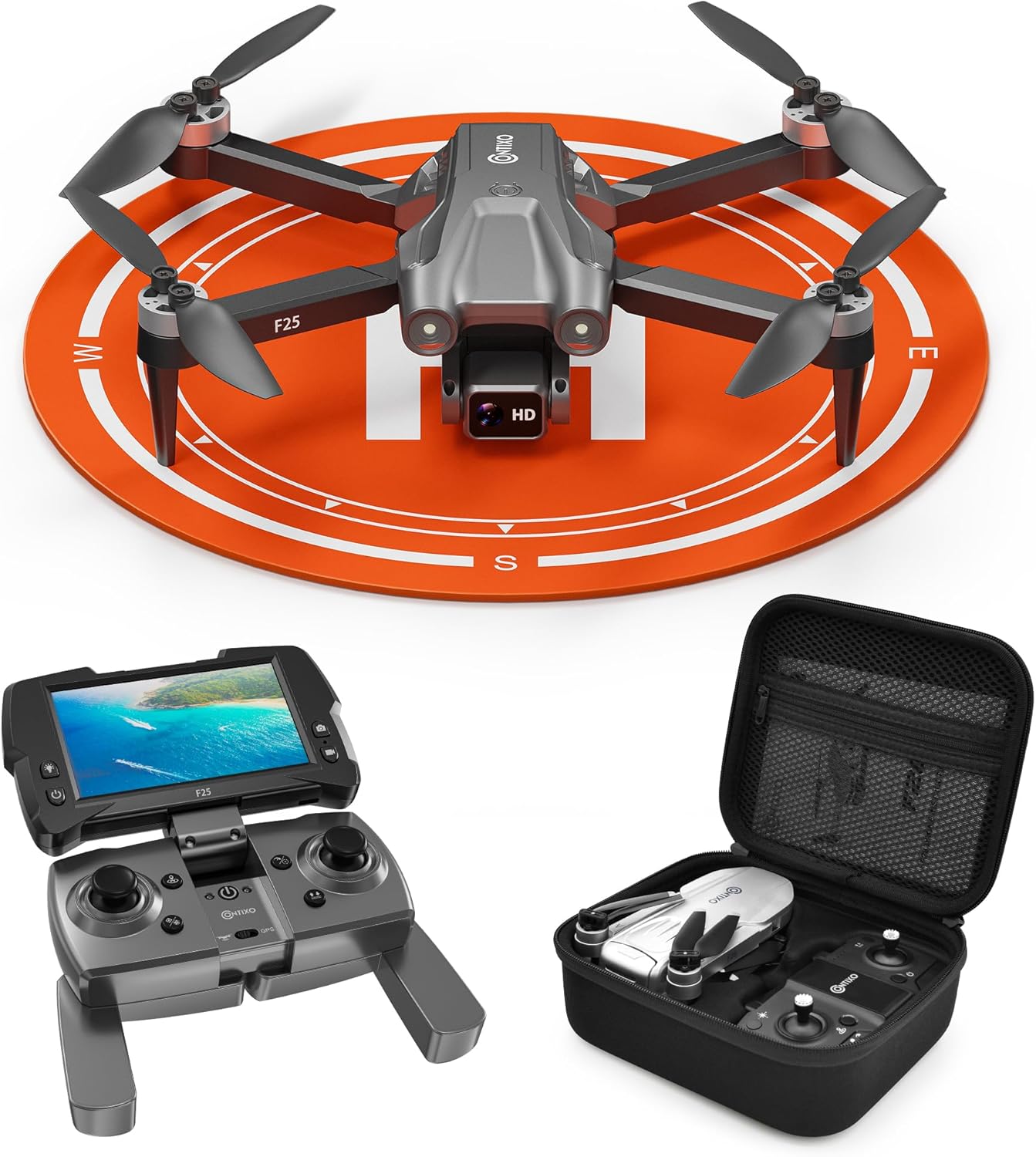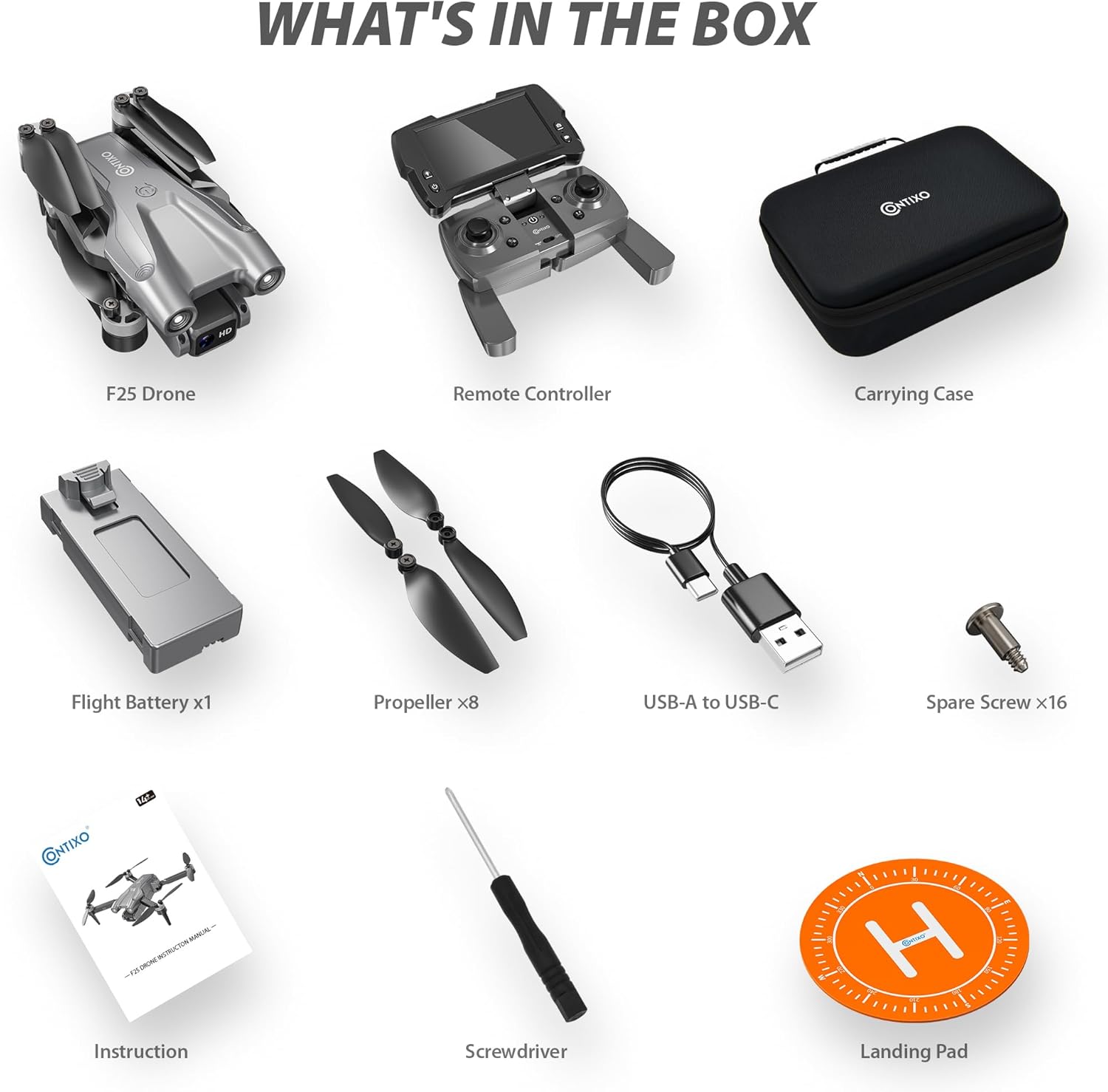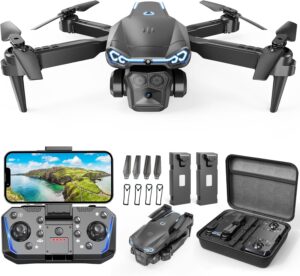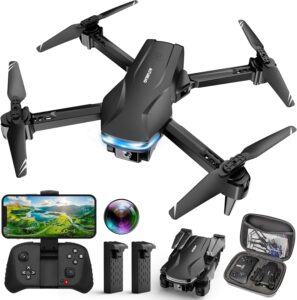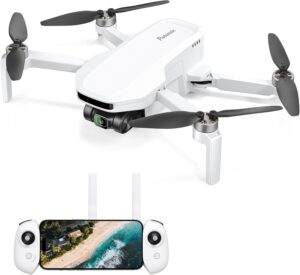Can a palm-size drone really make us feel like a competent filmmaker instead of someone chasing a mechanical fly around the backyard?
Why We Picked the Contixo F25 GPS Drone
We were looking for a drone that didn’t insist we hand over our phones, our weekend, and our dignity. The Contixo F25 GPS Drone with a built-in 4.3-inch HD screen on the remote promised we could leave our smartphone in our pocket and still get a live first-person view. It also promised GPS + GLONASS positional accuracy, a 1080p camera, and modes with names that sound like summer camp electives—Follow Me, Waypoint, Orbit, and Selfie. We were curious whether those promises would translate into crisp videos, fewer “where did it go?” moments, and a little bit of cinematic flair.
What’s in the Box
We appreciate when a kit looks like someone thought it through. The Contixo F25 arrives compact and squared away, with a foldable drone, a remote controller that’s already fitted with a 4.3-inch FPV monitor, a travel case, and even a small landing pad so we aren’t forced to christen our lawn as a runway. The drone weighs just 167 grams, which kept our paperwork to a minimum and our shoulders less tense. A charging setup and spare propellers are typically included with drones of this size; with the F25, what stood out was how quickly we were ready to fly.
The Elevator Pitch, If We Were Trapped Between Floors
We’d say: It’s a 167g, foldable GPS/GLONASS drone with brushless motors, a 1080p camera, and a 4.3-inch FPV monitor built into the remote, so we don’t need a phone to fly or frame shots. It flies up to around 16 minutes per battery, reaches roughly 600 feet in range, comes with Follow Me, Orbit, Waypoint, and Selfie modes, and returns home automatically if it gets skittish or tired.
Design and Build Quality
The F25 looks like it went to finishing school for drones—sleek lines, unobtrusive coloring, and arms that fold snugly against its body like it’s demonstrating proper airplane etiquette. The brushless motors are the real grown-ups in the room. They’re quieter than brushed motors, more efficient, and they don’t burn out after a few dramatic sprints into the wind. The overall build feels solid for a sub-250g craft, which makes sense given that stability is half the battle with camera drones.
Portability and FAA Considerations
At 167 grams, this drone doesn’t require FAA registration for recreational use in the United States. That said, we’re still responsible for following the rules: flying under 400 feet AGL, keeping the drone within visual line of sight, and avoiding controlled airspace unless we’ve obtained the required authorization. We like that the F25 lives in the sweet spot of “no forms to fill out” while still giving us GPS features usually reserved for bigger, “please register me” aircraft. The included case helps keep everything together, which reduces the chance that we’ll meet a lonely propeller in a pocket three weeks later.
Setup: Minimal Small Talk, Maximum Flight
We are not here for elaborate rituals involving firmware haikus. The F25 kept the setup minimal. We charged the battery, unfolded the arms, and skimmed the manual for the power-on sequence and calibration steps. We also inserted a microSD card into the drone itself, because the FPV monitor is strictly for live view—no recording. That arrangement suits us; we like keeping the monitor’s job simple while the drone handles the footage.
Calibrations That Make Sense
The GPS + GLONASS positioning system benefits from a quick compass and gyro calibration, which is quite standard. We’ve learned to think of calibration as a five-minute patience tax that pays dividends in stability and reliable return-to-home behavior. Once done, the F25 felt planted in the air, less like a nervous bird and more like a small, attentive helicopter.
Flight Performance: Calm, Composed, and Confident
This is where the F25 surprised us. For its size and weight, it held position well in typical suburban breezes. Brushless motors and a polished flight controller give it a steady hover, and the GPS/GLONASS combo helps it know exactly where it belongs. We didn’t feel like we were coaxing it into obedience; it responded with the easy confidence of a friend who’s good at parallel parking.
Range and Responsiveness
With a stated range of up to 600 feet, the F25 isn’t trying to win a marathon. It’s trying to keep us honest and within line of sight. Controls felt responsive, and the link between the remote and the drone held steady in our tests. For most vlogging, backyard filmmaking, and casual scouting, that range felt sufficient. We’d rather have consistent control within 600 feet than a theoretical mile that drops frames like confetti.
GPS Precision and Return-to-Home
We loved that return-to-home isn’t a drama queen. When the battery dips or the signal gets sketchy, the F25 retraces its steps and lands where it started—like a dog returning to its bed after realizing the couch is not an option. We recommend setting an appropriate RTH altitude before takeoff to clear trees and lamp posts. It’s one of those small preflight choices that keeps the flight uneventful in the best way.
Camera and 4.3-Inch FPV Monitor
The 1080p camera is the F25’s workhorse. It captures crisp footage in good light and handles typical daytime scenes well—parks, beaches, rooftops that make us feel like rooftop people. The FPV monitor is surprisingly freeing. We aren’t balancing a phone on the controller, fumbling with brightness settings, or juggling notifications. It’s just us and the live feed, which feels more like flying and less like checking an email inbox we didn’t ask for.
Image Quality and Low-Light Reality
At 1080p, the footage is perfectly shareable and reasonable for social media, travel logs, and family film festivals where the jury is our parents. In low light, physics rears its head, and noise will creep in—this is a small sensor, not a professional cinema rig. We found that golden hour looks pleasing and very forgiving. Midday sun benefits from a steady hand and perhaps a gentle back-off from particularly reflective surfaces.
Recording and Storage
All recording happens on the drone via a microSD card. The monitor does not record, which means the FPV screen is for framing and flying. That separation felt clean and dependable. We used a Class 10 or UHS-I card to keep write speeds brisk and avoid the heartbreak of stutters. Our best practice has become formatting the card in the drone before each shoot, like washing the dish before we put food on it.
Intelligent Flight Modes That Earn Their Names
We’ve met drones that treat “intelligent modes” like a bribe: fancy words for average behavior. The F25’s modes are refreshingly functional. They aren’t party tricks; they’re tools we found ourselves using regularly.
Follow Me
Follow Me is the mode that forced us to finally admit we do, in fact, have a “good side.” The F25 tracks us as we move, keeping us in frame while we go for a jog, a bike ride, or what we generously label “parkour” (stepping over a bench). The result looks like we hired a cautious, well-trained bird to be our cameraman. Is it perfect around complex obstacles? No—this isn’t an obstacle-avoidance system. But in open spaces, it’s steady, predictable, and flattering.
Orbit (Circle) Mode
Orbit mode turns us into that person who loves a reveal shot. The drone circles a point of interest we set—us, a statue, a picnic table where we’ve optimistically placed grapes—as it records a smooth, cinematic loop. It’s the type of shot that feels like it should require a thesis. On the F25, it’s a couple of button presses and a vague sense of accomplishment we will definitely overstate at dinner.
Waypoint Mode
Waypoint mode lets us sketch a flight path and let the drone follow it. It’s consistently good for survey-style shots, establishing passes, and “now we’re going from here to there” sequences. If we’re mapping a simple route for a video, waypoints give us a repeatable path—handy when the first take includes our cousin wandering into the frame, looking at the drone, and mouthing “Is it on?”
Selfie Mode
Selfie mode is a nudge to take ourselves slightly less seriously. It lines up a flattering frame and gives us time to pretend we didn’t rehearse our casual smiles. We used it as a test shot, a warm-up for more involved maneuvers, and a way to document our presence without transforming into a tripod sherpa.
Battery Life and Charging
The F25’s battery gives us up to about 16 minutes in the air, which is the realistic realm for a sub-250g drone with a 1080p camera and brushless motors. Wind eats minutes. Aggressive flying eats minutes faster. Calm, gliding flights with occasional recording make the most of the pack. We now treat each battery as a short film—plan the shots, get them, and land before the credits.
Charging Etiquette We Learned the Hard Way
- Let the battery cool before charging, like pasta before refrigeration.
- Keep batteries out of extreme heat or cold.
- Store partially charged if we won’t fly for a while.
- Label batteries with a tiny sticker so we rotate them and avoid playing favorites.
Range and Signal Reliability
The 600-foot range is honest. We kept the antenna orientation tidy, avoided metal picnic shelters and high-tension lines, and got consistently solid video and control links. This range also keeps us compliant with visual line-of-sight regulations and reduces the urge to test fate. If our shot demands more range, it’s usually a sign our script needs editing rather than our equipment.
Wind Handling and Brushless Benefits
Brushless motors are the unsung heroes here. They yield smoother throttle changes, better efficiency, and improved longevity. In breezy conditions, the F25 resisted drift and corrected quickly. It’s not a hurricane chaser—and none of us should be—but it keeps its composure in typical conditions. We noticed less vibration in the airframe than on similar-size drones with brushed motors, which pays off in steadier footage.
Storage, Files, and Workflow
We found our groove with a 32GB UHS-I microSD card, formatting it in the drone before each day’s flights. After landing, we pop the card and move files to a folder named by date and location, because we’ve learned that a folder labeled “Drone stuff” will soon become an archaeological dig. The FPV monitor’s job remains immediate and simple: live view. That division of labor keeps the workflow predictable—shoot, land, offload, edit, repeat.
Usability Without a Smartphone
The built-in 4.3-inch screen is the F25’s personality trait that we wish more drones had. It’s bright enough for typical daylight, and the quick-access buttons on the remote reduce menu scavenger hunts. Not having to connect a smartphone, babysit a cable, or fend off notifications turned the ritual of flying into, well, flying. We didn’t miss the app experience; we liked the appliance-like simplicity of a screen that exists solely to show us what the drone sees.
Quirks, Limitations, and Honest Trade-Offs
We are all collections of compromises—us, our breakfasts, and our drones. Here’s what we noticed.
- 1080p is the ceiling. If we’re aiming for 4K cinematic landscapes with multi-axis stabilization, we’re shopping in a different aisle with bigger price tags and possibly registrations.
- The monitor is for viewing, not recording. All recording happens on the drone’s microSD card.
- Flight time tops out around 16 minutes. It’s enough for thoughtful sequences but short for aimless wandering. Extra batteries are our friend.
- The range is 600 feet. For most of our shots, that’s plenty. For the occasional “let’s film that barn across the valley,” we brought our expectations closer.
- There’s no indication of a 3-axis mechanical gimbal. In practice, that means our footage stability relies on flight stability and internal processing; wind gusts can show up in the video.
- No obstacle avoidance. It’s not a bug; it’s an invitation to pick open flight areas and keep our eyes alert.
None of these are dealbreakers; they’re reminders of what this drone is designed to be: simple, competent, portable, and friendly.
Real-World Use Cases We Didn’t Make Up
We brought the F25 where we usually bring ourselves on weekends, minus the guilt over not using that gym membership.
- Travel vlogging: Instead of asking strangers to operate our camera and later discovering their artistic vision is “their thumb,” we flew the F25 for sweeping establishing shots and Follow Me sequences along trails.
- Backyard filmmaking: It made instantly better birthday videos, especially when we used Orbit around the cake. The frosting survived.
- Real estate-ish walk-throughs: Waypoints gave us repeatable paths along the street-to-doorline arc, which made our friend’s listing look like we knew what we were doing.
- Sports and outdoor activities: Follow Me kept us framed during a mellow bike ride, and the footage looked steadier than any phone strapped to a helmet.
Safety and Legal Notes We Live By
We like our hobbies unaccompanied by fines. For recreational flights in the U.S., the F25 doesn’t require registration given its weight, but we still:
- Keep it below 400 feet AGL.
- Maintain visual line of sight.
- Stay clear of airports and obtain authorization for controlled airspace when required.
- Respect privacy and avoid flying over people.
- Complete the TRUST test if we’re flying recreationally. Your country or region may have its own equivalents. Following rules is like wearing sunscreen; future us will be grateful.
Maintenance and Care
Small routines keep small drones feeling fresh:
- Check props before each flight; replace any with chips, bends, or that overall “I’ve seen things” look.
- Clean the camera lens with a microfiber cloth.
- Calibrate after transport or when the app/manual suggests it.
- Update firmware when available from the manufacturer to maintain stability and fix quirks.
- Store the drone and batteries in the included case to avoid impromptu yoga poses for retrieval from under the car seat.
Performance Benchmarks in Plain Language
We’re not a lab, but we are committed to honesty and snacks. Here’s how the F25’s key features translated to our experiences.
- Takeoff and hover: Predictable, quick GPS lock, stable hover in light to moderate breeze.
- Flight modes: Simple to engage; helpful for consistent shots; Follow Me behaves best in open areas.
- Camera: 1080p footage looks crisp in daylight; low light brings noise; quick pans can show some motion blur.
- FPV screen: Bright enough outdoors; a joy to use without a smartphone; no recording on the monitor.
- Battery: Around 12–16 minutes depending on conditions; pack a spare for a relaxed shoot day.
- Range: Stable control and video up to the stated range in open areas with mindful antenna orientation.
Feature Snapshot Table
A quick reference when we’re answering questions on a park bench.
| Feature | What We Noticed | Why It Matters |
|---|---|---|
| Weight | 167 grams | No FAA registration needed for recreational use in the U.S.; easier to carry everywhere. |
| Camera | 1080p FHD | Clean footage for social media, vlogs, and casual filmmaking; best in good light. |
| FPV Monitor | Built-in 4.3-inch HD screen | No smartphone needed; faster setup; fewer distractions. |
| Positioning | GPS + GLONASS | Stable hover, reliable RTH, better hold in breezy conditions. |
| Motors | Brushless | Quieter, more efficient, more durable than brushed counterparts. |
| Flight Time | Up to 16 minutes | Plan shots; bring extra batteries for longer sessions. |
| Range | Up to 600 ft | Keeps us honest with line of sight; solid control within limits. |
| Smart Modes | Follow Me, Waypoint, Orbit, Selfie | Cinematic shots with minimal effort; repeatable paths. |
| Safety | Auto Return-to-Home | Reduces flyaway anxiety on low battery or signal loss. |
| Portability | Foldable + travel case + landing pad | Easy to pack and deploy; clean takeoff/landing in grassy areas. |
| Storage | microSD on drone; monitor doesn’t support SD | Recording stays on the aircraft; FPV used strictly for live view. |
Who This Drone Is For
We’re convinced the F25 was designed for people who want to fly more than they want to fuss.
- Beginners who want GPS stability and a straightforward remote with a built-in screen.
- Travelers who value a tiny, foldable, no-registration-needed craft for quick scenic shots.
- Content creators who prioritize convenience and can work beautifully with 1080p footage.
- Families who want safer, auto-return features and easy-to-understand flight modes.
- Hobbyists who prefer brushless motors and GPS/GLONASS positioning without spending big.
Who Might Want Something Else
If we’re chasing pro-grade footage, longer flight times, or obstacle avoidance, we’ll be happier stepping up to larger, pricier aircraft with 4K cameras and multi-axis gimbals. Similarly, if we need mile-plus transmission or industrial mapping features, the F25 sits outside that mission profile.
The Intangibles That Won Us Over
We’ve flown enough drones to know the difference between “capable” and “cold.” The F25 feels friendly, in the way a well-designed kitchen tool invites us to cook dinner instead of making reservations. The 4.3-inch screen and the tidy flight modes reduce friction. The brushless motors and GPS + GLONASS lend the confidence that let us focus on our shots rather than our heartbeat.
Tips for Better Footage With the F25
We learned these through small triumphs and a few “let’s never speak of this again” moments.
- Keep movements slow and deliberate. Small control inputs translate into smoother footage.
- Use Orbit and Waypoint for your most important shots. They reduce hand jitters.
- Fly during golden hour. 1080p loves soft light.
- Set RTH altitude higher than the tallest object nearby.
- Check the microSD card before takeoff; a missing card turns an award-winning shot into a rehearsal.
- Frame with foreground elements where possible; it adds depth and elevates even simple scenes.
Troubleshooting Without Tears
- FPV screen looks dim: Shade it with a cap or position your back toward the sun; increase screen brightness if the settings allow.
- Shaky footage: Fly slower, avoid high winds, and consider reducing quick yaw movements.
- GPS won’t lock quickly: Move to an open area, away from buildings or thick tree canopies; wait a minute longer before taking off.
- Return-to-home is off by a few feet: Recalibrate compass and make sure the home point is recorded after GPS lock at takeoff.
Environmental Considerations
We try to be good guests wherever we fly. With the F25’s quiet brushless motors, we found it less intrusive around people and wildlife, but we still fly with care. We keep distance from birds, avoid nesting areas, and resist flying near crowds. The included landing pad helps avoid kicking up dust or debris, which is better for the camera, the motors, and everyone’s eyes.
Teaching Moment Approved
For those of us introducing a friend, a parent, or a brave child to drones, the F25 is a gentle teacher. The auto return-to-home and steady hover build trust quickly. Smart modes create instant gratification, which keeps the enthusiasm alive long enough to talk about safety, airspace, and the difference between curiosity and bravery.
How It Stacks Up in the Real World
We’ve flown similarly priced minis that demand a smartphone, offer shaky transmissions, and get flustered by wind. The F25 stands out by giving us:
- A dedicated FPV monitor, which removes the app setup dance.
- GPS + GLONASS, improving positional accuracy versus GPS-only systems.
- Brushless motors in a small, travel-ready body.
- A straightforward suite of smart modes that we actually used.
It doesn’t pretend to be a 4K powerhouse. It doesn’t try to be our phone’s best friend. It tries to be our flying camera that just works, and on that front, it succeeds.
Packing Checklist We Actually Use
- Drone with charged battery
- Remote with attached FPV monitor
- Spare battery or two (if we own extras)
- MicroSD card(s), formatted and labeled
- Charging cable and wall adapter
- Landing pad
- Microfiber cloth for the lens
- The case, because we’ve learned our pockets cannot be trusted
A Day in the Life With the F25
We arrive at the park later than planned because our shoes have opinions. We unfold the drone, the arms click into place, and the remote’s screen lights up with an image of our knees, which look younger than we remember. GPS lock arrives, and takeoff is gentle—up, hover, wait, like a courteous elevator. We set Orbit around a tree that’s doing the most with its leaves, capture a slow arc, then switch to Follow Me as we trot down a path, waving to a cyclist who waves back because human kindness exists. The battery beeps its version of “I’m hungry,” and we tap return-to-home. The drone returns, unruffled, like a cat deciding the adventure is over, for now. We pop the microSD card, drop files into a “Park_Weekend” folder, and later, on our couch, see the shots on a larger screen. They look steady, colorful, and surprisingly grown-up. We decide we’ll go again next weekend and maybe bring better snacks.
Value and Longevity
We judge drones not just by their first flights but by their third month. The F25 has the build and features that age well—brushless motors for durability, GPS/GLONASS for stable positioning, a portable body we won’t hate carrying, and a basic camera that performs reliably in good light. Accessories like extra batteries extend usefulness, and because we aren’t shoehorned into a phone app, the overall experience remains consistent over time.
The Bottom Line We’d Tell a Friend
If we want a small, travel-ready drone that gives us GPS + GLONASS positioning, brushless motors, a genuinely helpful 4.3-inch FPV monitor, and a set of intelligent modes that make our videos look composed, the Contixo F25 is a smart, friendly pick. It’s perfect for those of us who favor simplicity and craft over spec-sheet bragging rights. We can launch quickly, frame cleanly, and bring it home safely—over and over—without feeling like we’re beta-testing our own patience.
Our Verdict
We think of the Contixo F25 GPS Drone as a reliable companion: the friend who knows the scenic overlook and also remembers to bring water. It’s compact at 167 grams, spares us from phone-mount contortions with its 4.3-inch FPV monitor, and earns its place in our bag with stable GPS + GLONASS hovering, gentle brushless motors, and a 1080p camera that shines in good light. The 16-minute flight time and 600-foot range keep us grounded—and well within visual line of sight—while Follow Me, Waypoint, Orbit, and Selfie modes hand us shots that look planned, even when they were spur of the moment.
We’ve flown it, trusted it, and carried it around enough to know it’s not a novelty. It’s a capable little storyteller that asks very little and delivers more than we expected. If our goals include clean travel footage, easy vlogs, and weekend adventures without the friction of phone apps and heavy rigs, the F25 fits. It may not turn us into directors, but it does make us feel like the story is right there, within 600 feet, ready to be told.
Quick Pros and Cons, So We Can Get Back Outside
What We Love
- Built-in 4.3-inch FPV screen on the remote means no smartphone required.
- GPS + GLONASS keeps hovering steady and return-to-home reliable.
- Brushless motors deliver quiet, efficient performance.
- Compact and FAA-exempt for recreational use in the U.S. due to its 167g weight.
- Intelligent flight modes that are actually usable: Follow Me, Orbit, Waypoint, Selfie.
- 1080p camera that looks crisp in good lighting conditions.
- Travel case and landing pad make us look like we planned this, because we did.
What We Accept
- 1080p only; no 4K option.
- About 16 minutes per battery; extra batteries recommended for longer sessions.
- 600-foot range is practical but not for long-distance ambitions.
- No indication of a 3-axis gimbal; stability depends on flight behavior and conditions.
- No obstacle avoidance; best in open, safe areas.
Final Thought Before We Pack Up
We will always admire the drones that require a convoy and a spreadsheet, but we’re increasingly partial to the ones that slip into our day and come back with something pretty. The Contixo F25 GPS Drone is exactly that kind of companion—thoughtful, portable, and game for whatever story we’re ready to tell next.
Disclosure: As an Amazon Associate, I earn from qualifying purchases.
